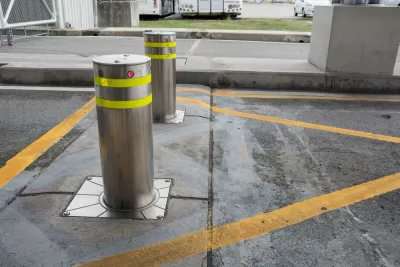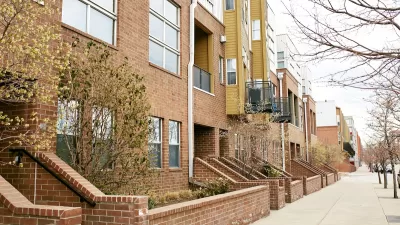Roadway designs protect drivers and construction workers with robust barriers. Why don't we protect pedestrians in the same way?

Assessing the different types of barriers installed on American roadways, Charles Marohn argues that we need beefed-up protection for pedestrians, much like we provide for drivers or construction workers. At roadway construction sites, Marohn writes, "[t]he concrete barriers do not have a breakaway design. There are no shear pins to absorb the kinetic energy of an errant vehicle. A driver who loses control in a construction zone is going to feel the brutal consequences of that mistake. The construction worker will not."
Marohn asks, "[w]hy are we concerned with the construction worker and not the kid walking the sidewalk? Why are we concerned with the oncoming traffic and not the person waiting at the traffic signal?" Historically, roadway designs have ensured protection for drivers while ignoring people on the sidewalk who might get struck by out-of-control cars.
"America needs a billion bollards. There is no coherent argument against lining every street in America with them. This is the minimum level of protection needed to keep people safe from violence. It is the least we can do to correct the massive asymmetry of risk experienced on our nation’s streets by people outside of a vehicle."
To improve transportation, Marohn asserts, "skip the megaprojects." Not doing more to protect pedestrians amounts to "institutionalized gross negligence."
FULL STORY: One Billion Bollards

Alabama: Trump Terminates Settlements for Black Communities Harmed By Raw Sewage
Trump deemed the landmark civil rights agreement “illegal DEI and environmental justice policy.”

Planetizen Federal Action Tracker
A weekly monitor of how Trump’s orders and actions are impacting planners and planning in America.

The 120 Year Old Tiny Home Villages That Sheltered San Francisco’s Earthquake Refugees
More than a century ago, San Francisco mobilized to house thousands of residents displaced by the 1906 earthquake. Could their strategy offer a model for the present?

In Both Crashes and Crime, Public Transportation is Far Safer than Driving
Contrary to popular assumptions, public transportation has far lower crash and crime rates than automobile travel. For safer communities, improve and encourage transit travel.

Report: Zoning Reforms Should Complement Nashville’s Ambitious Transit Plan
Without reform, restrictive zoning codes will limit the impact of the city’s planned transit expansion and could exclude some of the residents who depend on transit the most.

Judge Orders Release of Frozen IRA, IIJA Funding
The decision is a victory for environmental groups who charged that freezing funds for critical infrastructure and disaster response programs caused “real and irreparable harm” to communities.
Urban Design for Planners 1: Software Tools
This six-course series explores essential urban design concepts using open source software and equips planners with the tools they need to participate fully in the urban design process.
Planning for Universal Design
Learn the tools for implementing Universal Design in planning regulations.
Clanton & Associates, Inc.
Jessamine County Fiscal Court
Institute for Housing and Urban Development Studies (IHS)
City of Grandview
Harvard GSD Executive Education
Toledo-Lucas County Plan Commissions
Salt Lake City
NYU Wagner Graduate School of Public Service





























